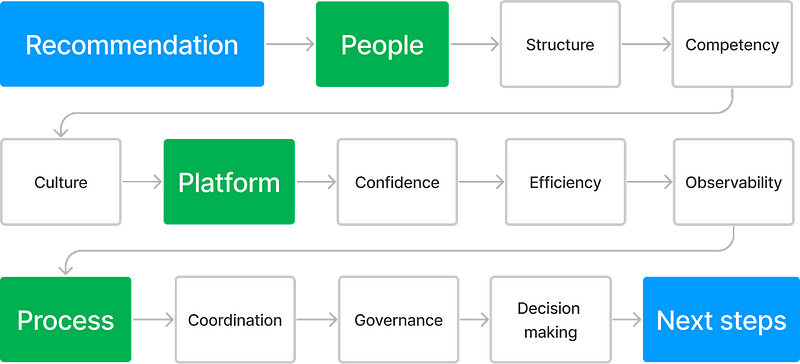Scaling technology teams: the three essential things I learned
Over the last two decades (man, I am old), a recurring challenge has been providing a view of the capability of a technology organisation…
Over the last two decades (man, I am old), a recurring challenge has been providing a view of the capability of a technology organisation and presenting a change plan. Whilst the reasons for this have varied (a 100-day plan after starting a new role, aligning teams to a new ambitious strategy or due diligence for a potential acquisition), the difficulty is always finding where to focus and explaining your thinking in a simple, coherent way.
To do this successfully, you must address two main challenges. First, the breadth of different interconnecting factors involved in what makes an effective technology team makes it hard to review and explain. The second is that there isn’t a single “perfect” solution to check against or move towards. What is deemed good changes depending on the organisation’s size, the people involved and the business challenges (there is even a pattern).
Like any problem, diagnosis is vital. Having heuristics — a set of loose rules — to form a lens through which to view the problem can help simplify this process. It can provide a shortcut in prioritising what to look at and, importantly, where agreement is needed.
Over the years, I have looked to others’ experiences to build my understanding. This search has involved reading a lot about the subject and, most valuable of all, talking to people who have been through the process. Getting their first-hand experiences, warts and all, of what they came up against was invaluable.
Common patterns and elements emerged with each conversation, book, blog post, and iteration. I have continually collected and refined these, eventually abstracting them into a simple model. It is something I reach for whenever I review teams.
The 3Ps
Taking heavy inspiration from The Book of Armaments, I identified three areas to understand — People, Platform and Process; each with three key aspects that, when understood, clearly indicate how effective the team is.
The model is opinionated about the areas that indicate a technology team’s capability. However, defining the specific criteria is a collaborative process with the rest of the business. Doing so ensures alignment with the business’s current growth stage and goals.
People
People are crucial to the success of a business. They bring the knowledge, skills and creativity essential for innovation, problem-solving and driving day-to-day performance. However, creating an environment and support structures that get the best out of them is equally important.
When reviewing people, it is essential to define and understand:
Competency — the skills, specialist knowledge and seniority that are needed to tackle the business’s current challenges
Structure — the organisation designs that can effectively support both the team and the organisation’s continued growth
Culture — what does an engaging and effective environment look like
Platform
Technology platforms play a pivotal role in how effective technology teams can be. They cover the infrastructure, systems and reporting capabilities on which the business is built and operated. You must consider and balance where you put the effort aligned to the business goals.
When reviewing the platform, it is essential to define and understand:
Confidence — the level of risk you’re willing to tolerate when making changes or running at scale
Efficiency — how cost-effective should it be to run, operate and scale the systems
Observability — level of visibility required to understand and monitor performance
Process
The final area in the model is the technology teams’ processes and, importantly, how they fit into the wider business. Applying the proper approach can bring structure and clarity to what can be very complex work. As the team grows, it can also ensure consistency, efficiency and the operational excellence needed to scale.
When reviewing processes, it is essential to define and understand:
Coordination — what type of changes are required, from macro-level strategic coordination to micro-level optimisation, and how should this be achieved
Governance — what defines regulatory and operational perspective
Decision-making — the way teams should balance day-to-day operations, localised improvements and strategic delivery
Applying the model
With the model in place and contextual definitions provided for the challenges faced, the next step is understanding and evaluating the current capabilities. The basis for evaluation should be as data-assisted and objective as possible.
You can look for much of this data in the standard places: cost data from your cloud provider, incident management, and any project management tools and processes. Depending on the maturity of the business, some of the information may not be available. However, this is both useful for the evaluation and indicates where to focus to enhance the data in the future.
Some areas are more challenging to measure, but some tools can help form the basis of your diagnosis. The HR systems in the company often provide a wealth of people data that can help. Whilst it usually needs to be better formatted, you can look at the distribution of skills, seniority and time in the business with some manipulation. You can also use this data to visualise the shape of the organisation through reporting lines.
Surveys are another great source of data about how the teams feel. Using qualitative data, you can understand the level of engagement and experience in the company and where the issues are. You can also get more specific data on the technology and processes through a team health check or listening sessions with team members.
Finally, it’s vital to contextualise the current performance with industry benchmarks. For instance, when looking at the platform, understanding where you rank against the DORA metrics will give a good idea of relative performance, or if you’re looking at the governance of Business IT, there are specific maturity models that can help.
Presenting back
Presenting your findings and a recommendation is an integral part of the process. It allows people to give feedback and provide input, ultimately ensuring alignment on the way forward.
Building this presentation can be difficult due to the large amount of information to process, even with the overlay of a model, especially for a non-technical audience. However, the structure of the model lends itself well to Barbara Minto’s Pyramid Principle.
It’s a simple concept, useful when logically presenting complex arguments. It states that “ideas in writing should always form a pyramid under a single thought”.
In this case, the single thought is the recommendation of your findings, and underneath are the supporting arguments arranged around the three areas, followed by the data and facts you can build the summary on. Every level in the pyramid must summarise what is below.
You can then transform this pyramid into an easy-to-follow storyboard for your presentation.
Starting with your recommendation is crucial as it allows people to anchor to your solution and assess each supporting element as you move through. It is much easier for the audience than putting it all together at the end themselves.
To conclude your presentation, summarise the plan for the roll-out and ensure you have measures of success framed in the business impact they will have. The heuristics in the model also provide a way of tracking and reporting your progress over time.
Applying it at loveholidays
Four years ago, I joined loveholidays as the CTO. At the time, it was a founder-led, fast-growth start-up with ambitious growth targets. I used this model to review the teams, formulate my plan, and present it to the board.
The founders had built a market-leading business on innovation and a daily obsession of improving 1%. However, the technology teams’ capability needed to evolve to meet the company’s ambitions and sustain its growth.
It led me to recommend a radical overhaul of the business’s approach to technology, requiring professionalisation in several areas in parallel with significant investment. Specifically:
People: Complement the current teams’ industry expertise with specialist knowledge and a structure to support increasingly complex technology challenges
Platform: Build increased confidence and scalability through re-architecting the systems around key business capabilities
Process: Deliver sustained optimisations that balance commercial and technical excellence by expanding the horizon of prioritisation
These changes were a big ask even during the “honeymoon period” after starting a new role. Having a way of breaking down the proposal to get alignment helped, especially with some of the controversial changes.
Whilst it didn’t all go perfectly — I had misjudged the alignment on decision-making and governance, for example — it allowed people to give feedback. Where there was specific disagreement, I could address this without impacting the overall plan.
Ultimately, the recommendation and subsequent changes to loveholidays provided the foundations for our continued success: the resulting business growth, awards for our world-leading innovation and recognition as a great workplace all speak for themselves.
Perhaps more importantly, the continued measurement of these areas has also ensured ongoing investment by showing their correlation to business impact.
Closing thoughts
As with many problems, decomposition is essential. Its many benefits include helping manage complexity, improving understanding and facilitating collaboration. Having a simple model as a basis to review teams has been invaluable in helping to break the problem into manageable chunks. I am refining the model and approach with each iteration and conversation.
If this sounds like something that could be useful, I suggest first reviewing the model against your own experience. Whilst People, Process and Platform provide an excellent high-level framework, the elements that define them can, and should, be updated to match your expectations. Remember though: “Four shalt thou not have, neither have thou two, excepting that thou then proceed to three. Five is right out”.
Once it fits your understanding:
Work with the business to agree on a definition of good.
Review the organisation in each of the areas.
Create a plan to address each element.
Present back in a simple way using something like the pyramid principle.
Continue to measure and report progress periodically.






